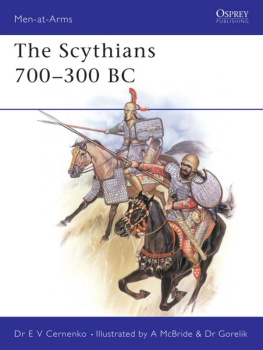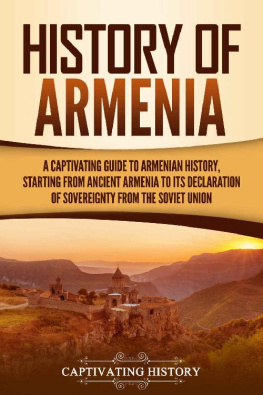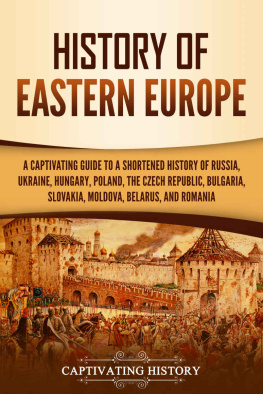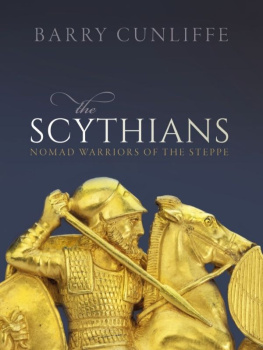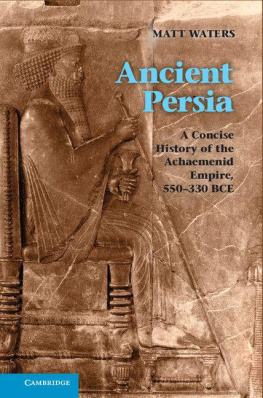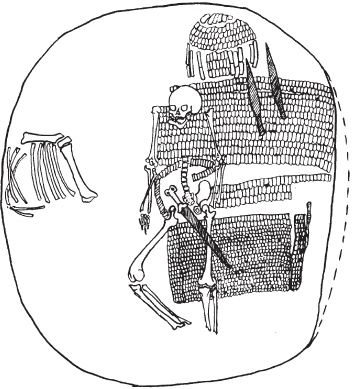Men-at-Arms 137
The Scythians 700300 BC
Dr E V Cernenko Illustrated by A McBride & Dr Gorelik
Series editor Martin Windrow
Content
The Scythians 700300BC
Introduction
The text which follows is a translation from the Russian original commissioned by Osprey from the distinguished Soviet archaeologist Dr. E. V. Cernenko, of the Archaeological Institute of the Academy of Sciences of the Ukrainian SSR. The acting head of that institutes Scythian Department, Dr. Cernenko has been active in the excavation of Scythian tombs for many years. The colour plates by Angus McBride are based upon reconstructions prepared for this book by Dr. M. V. Gorelik of the Oriental Institute of the Academy of Sciences of the SSSR, Moscow. Much of the written and pictorial material in this book is published here for the first time in the West.
Although little known to non-specialists in this period and region, the Scythians were a dominant influence in South-East Europe and the Middle East for more than three centuries, being roughly contemporaneous with the Classical Greek world. They were the first of the great armies of horse-archers out of the East which were to have such an impact upon the consciousness of Europe at intervals over about 2,000 years. Yet they were not, like the Huns and Mongols, a Turco-Mongoloid race, but straight-featured Indo-Europeans: we know this from surviving pictorial metal-work, and from the few scraps of their language which come down to us through the Greek historians.
Their mastery of the horse and the bow raised them from the obscurity of nomadic stock-raisers of the steppes to the status of a major military power. At different periods they brushedhard, and bruisinglyagainst the Assyrians, the Medes, the Persians, and the Macedonians. In the centuries of their greatness they ruled a huge area of what is now the Soviet Union; interestingly, they seem to have retained their nomadic ways, while establishing an apparently stable relationship with the vassal communities of settled farmers from whom they took tribute in a systematic way.
Although they left no written record, we know more of the habits and appearance of the Scythians than we do of many more recent cultures. The southern part of their range met the northern limits of the Greek world in the Greek trading cities along the north shores of the Black Sea; and it was here that Herodotus, father of history, gathered the impressions of them which are still today our major written source. Here, also, they encountered skilled Greek metalsmiths. It is our good fortune that these violent, colourful, hard-drinking barbarians had a great love of decorative work in precious metals; a great wealth of such metals; the good taste to commission Greek master-craftsmen; and funerary customs which have preserved these precious relics for the study of the historian.
The Editor
The Scythians lived in the Early Iron Age, and inhabited the northern areas of the Black Sea (Pontic) steppes. Though the Scythian period in the history of Eastern Europe lasted little more than 400 years, from the 7th to the 3rd centuries BC , the impression these horsemen made upon the history of their times was such that a thousand years after they had ceased to exist as a sovereign people, their heartland and the territories which they dominated far beyond it continued to be known as greater Scythia.
Sketch of the contents of a Scythian warriors burial mound opened in the Nikolaev region. Dating from the 5th century BC , the tomb contains a complete suit of scale armour, including a helmet and leggings: cf..
Comparative chronology of principal events in Scythian and Greek history
| Scythians | Greeks |
| c.3200 BC |
| Horse domesticated in southern Russia |
| c.1500 BC |
| Steppes inhabited by semi-nomadic horse-breeding tribes |
| Early 7th C. BC | 7th C. BC |
| Cimmerian and Scythian conquest of Urartu; Scythian activity in Middle East recorded in Assyrian texts | Poetry of Hesiod |
| 670s BC | c.664 BC |
| Scythian king Partatua fights Assyria, marries daughter of Assyrian ruler Esarhaddon | First recorded naval engagement, between corinth and Corcyra (Corfu) |
| Mid-7th C. BC |
| King Madyes leads Scythian expedition to borders of Egypt |
| c.652626 BC | 640s BC |
| Period of Scythian influence in Media | Poetry of Archilochus; first minting of coins in Asia Minor |
| 621 BC |
| Draconian laws in Athens |
| 612 BC |
| Medes and Scythians capture Nineveh and destroy Assyrian Empire |
| Late 7th C. BC |
| Medes drive Scythians north of Caucasus into north Pontic area |
| Early 6th C. BC | 594 BC |
| Scythian philosopher Anacharsis travels in Greece | Solonian laws in Athens |
| 519 BC |
| Athens and Plataea defeat Thebes |
| c.514512 BC | 511 BC |
| Scythians repel Persian invasion of south Russia under Darius the Great | Spartan campaign against Athens |
| c.496 BC | Early 5th C. BC |
| Scythian expedition to Chersonesus in Thrace | Writings of Aeschylus |
| Late 490s BC | 490 BC |
| Scythians negotiate alliance against Persia with Spartan king Cleomenes I | Battle of Marathon
480 BC
Battles of Thermopylae and Salamis |
| Mid-5th C. BC | c.450 BC |
| Reign of King Scyles | Herodotus visits trading colony at Olbia and records description of Scythians |
| c.350 BC | c.437 BC |
| Beginning of Sarmatian expansion into Scythian territory | Pericles sends expedition to Black Sea area |
| 339 BC | 338 BC |
| Scytho-Macedonian war: King Atheas killed in battle with forces of Philip II in Rumania | Philip II defeats Athens and Thebes at Chaeronea |
| 330 BC | 323 BC |
| Alexanders general Zopyrion is routed by Scythians near Olbia | Death of Alexander the Great |
| 310309 BC |
| Scythians defeat Caucasians at Thatis River |
| c.200 BC |
| Scythians gradually withdraw into Crimea |
| 110106 BC |
| Scythians defeated in Crimea by King Mithridates Eupator of Pontus (Bosphoran kingdom) |
From the very beginnings of their emergence on the world scene the Scythians took part in the greatest campaigns of their times, defeating such mighty contemporaries as Assyria, Urartu, Babylonia, Media and Persia.
The ancient Greek historian Herodotus recorded that Cimmerian tribes had inhabited the Black Sea steppes before the Scythians. Then came the Scythians, and conquered the Cimmerians. Pursued by the Scythians, Cimmerian nomads crossed the Caucasus and spread into the countries of western Asia; and the pursuing Scythians, led over the mountains by their king Madyes, defeated the Medes they found in their path.
Early in the 7th century the Scythians moved against Assyria. The official records of Assyria are highly selective, giving much space to Assyrian victories but remaining silent about Assyrian defeats. Fortunately, a more balanced picture can be built up by comparing various surviving sourcesnot only the official record, but also the reports of spies, and the questions put by Assyrian kings to oracles when seeking advice.

